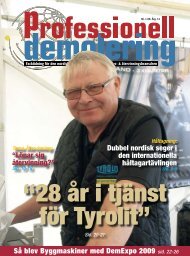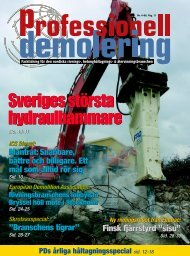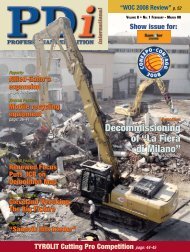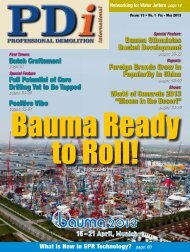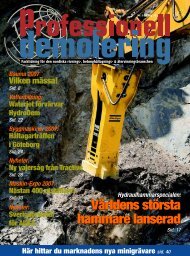Hitachi's Silver Lining - Pdworld.com
Hitachi's Silver Lining - Pdworld.com
Hitachi's Silver Lining - Pdworld.com
- No tags were found...
Create successful ePaper yourself
Turn your PDF publications into a flip-book with our unique Google optimized e-Paper software.
Movers and shakers:Rusch unlimitedPDi’s new series Movers andShakers feature dedicatedto the demolition industry’strendsetters rolls on. The currentepisode features Rusch,the Dutch manufacturer creatingexotic demolition giantsthat look as if they camestraight from a sci-fi movie.A cross between a demolition excavator and a crane, Ruschmachines are capable of bringing a building down from ashigh as 90 m. The sky is definitely the limit when Ruschset itself a new challenge.High-reach manRusch’s owner and managing director, Ruud Schreijer, is ahuman equivalent of the machines he devises. Extremelytall and powerfully built, Ruud is very imposing. He hadacquired a vast experience in the crane industry by workingfirst for Zandaam-based Kenz Kraantechniek, then for theBritish Kenz Cranes Ltd for almost ten years. In 1991, heventured out with his own <strong>com</strong>pany called Rusch. GivenRuud’s extensive background in cranes, it is a small wonderthat repairing telescopic booms for mobile cranes becameRusch’s core business. It is believed there are only three<strong>com</strong>panies in the world that provide that kind of service,and Rusch is proud to be one of them. A few years later,the <strong>com</strong>pany added offshore crane inspection, testingand certifying of lifting and fire-fighting equipment to itsscope of activities.Taking on demolitionIn 2003 when the Dutch economy plunged into recession,Rusch found itself in dire straits. With 40 people on thestaff and no work, it became painfully obvious that the<strong>com</strong>pany needed to find a project with a longer lead-time<strong>com</strong>pared to Rusch’s usual range of services. An opportunitypresented itself in 2005 when the Dutch contractorBeelen approached Pon Equipment, the Caterpillar dealerin the Netherlands and a long-time partner of Rusch, witha tall order of building a 60 m demolition rig. Beelen alsowanted the machine to be CE certified. A joint team ofRusch and Pon Equipment engineers worked on thisproject for almost a year to deliver Europe’s highest demolitioninstallation in 2006. The TUHD 60 (TelescopicUltra High Demolition) was based on a Cat 385 excavatormodified by Rusch to ac<strong>com</strong>modate a specially designed60m boom carrying a 2.5t demolition tool. The TUHD60 was Rusch’s first foray into the demolition sector, andthe <strong>com</strong>pany learned a lot from the experience. The nextdemolition project, which took place in 2007, saw Ruschbuild its first triple-boom machine. With the boom designedto move 33m up and 20m down, the triple-boom33-15 was equally suited for high-reach and harbour applicationssuch as demolition of shipwrecks.Reaching for the skyBut the real breakthrough came one year later when Ruschmade headlines with the world’s highest demolition craneTUHD 90-5. This 90m monster was ordered by a Dutchdemolition contractor for ultra high-reach demolition jobs.Nobody had ever attempted anything this big before, butRusch always thrived on challenges. A 130t Cat 5110 Bexcavator, which was chosen as the rig carrier, underwentso many modifications that it was hardly recognizable. Itsbody was made longer and wider, and its tracks lengthenedby 2.5m. The base machine carried a 90m telescopic boomwith a 5t tool controlled by an enhanced electro-hydraulicsystem developed in-house by Rusch. When fully assembled,the TUHD 90-5 makes a jaw-dropping sight. Bybuilding it, Rusch has proved once again that the ability tocreate something truly extraordinary can only be limitedby a creator’s imagination and self-imposed restrictions.The Big Wolf projectIn 2009, Norway-based AF De<strong>com</strong> won a contract todemolish nine offshore platforms from the North Sea.The project called for the platforms to be brought onshoreone by one by a barge, where AF De<strong>com</strong> was to dismantlethem before the next barge came in. It was obvious to thecontractor that cutting the platforms to transportable pieceswith shears would be the fastest option. But the problemwas that the cutting had to be done at a height of 50m,with the structures to be cut being 915mm diameter steelpipes. The only suitable tool for a job like this might be a25t shear. All those constraints meant that a very specialmachine was to be used on the project, so AF De<strong>com</strong> wenton the Internet looking for a possible supplier. The momentthey came across a TUHD 90-5 video, they knew that theyhad to look no further. Soon after the initial contact wasmade, Rusch delivered its first proposal in accordance withthe job specification.AF De<strong>com</strong>, however, felt that the estimated budgetmight be an issue and asked Rusch to <strong>com</strong>e up with analternative. This is how the Triple 34-25 model, designedfor 34m high-reach demolition work, was created. The newdesign won the approval of AF De<strong>com</strong>, and Rusch wasordered to deliver the machine within 10 months. Ruschopted to use a Caterpillar 5130B as the Triple 34-25 baseand a Genesis GPX 2500R shears for steel cutting. Theforce that the GPX 2500R shears generated proved to bea major challenge on this project. When the tool was notoptimally positioned relative to the object, the powerfulreaction force went through both the object and the boom.The reaction force was, in fact, so big that, theoretically, itcould move the entire machine. Rusch solved this problemby developing the revolutionary EXPREV system (EXceptionalforce PREVenting system) that absorbed the excessiveforces created by the shears.The system was not the only innovation born outof the cooperation between AF De<strong>com</strong> and Rusch. AFDe<strong>com</strong> requested the Dutch manufacturer to <strong>com</strong>e upwith a solution to protect the boom cylinders, and Ruschduly obliged. The solution they found was a thick rubberpad over the cylinders. Since operational safety is of paramountimportance on high-reach jobs, the Triple 34-25 wasequipped with a <strong>com</strong>puter-assisted safety system similar tothat used in the TUHD 90-5. The system constantly tracksdown the boom reach to avoid the danger of capsizing. Theangle sensors record the exact positions of the elementsand send a signal to the central processing unit. The unitcalculates the centres of gravity and outputs this data onto the touch screen installed in the cabin. When 90% ofthe maximum reach is achieved, the pre-alarm indicatorlights up. At 100% of the permissible reach, the controlunit receives a signal to shut down the hydraulics andimmobilizes the machine. AF De<strong>com</strong> was delighted withthe machine performances, and the job was successfully<strong>com</strong>pleted. Since the Big Wolf project, the Triple 34-25has proved its worth many times and is still in high demandfor offshore platform demolition jobs.RS4500 seriesIf Rusch had only built the TUHD 90-5, it would havebeen enough to secure the <strong>com</strong>pany a prominent place inthe history of controlled demolition. But even with fourdemolition crane projects under its belt, the manufacturerrefuses to rest on its laurels. The new project, the RS4500series, is now underway at Rusch. This series is based onan 85t excavator and designed to operate with either atelescopic or knuckle boom. One of the RS4500’s featuresis versatility. The machine is suitable for a broad range ofapplications, including Rusch’s trademark high-reach jobsas well as digging and foundation ripping. The new seriesis expected to be released in the autumn.www.rusch.toThe triple-boom 33-15 is equally suited for highreachand harbour demolition applications.Issue 2 • May - June 2011 • PDi 39




